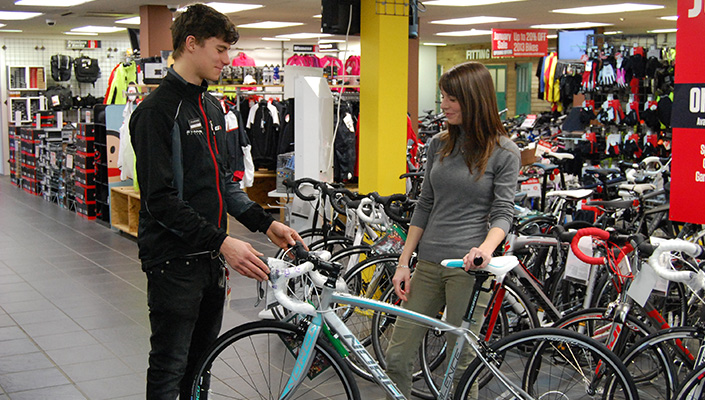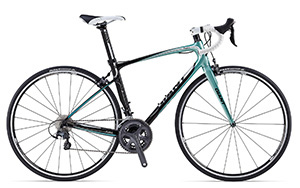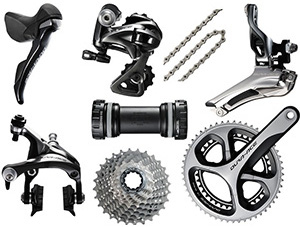
Over the years, market trends in bicycling have changed dramatically, and the number of choices you now have is greater than ever before. Right now, the market "sweet-spot" is a carbon-framed road bike priced right around $2500.
There is a dazzling array of bicycles on the market with all sorts of code names and jargon to describe them...and just as many people ready to put their 2 cents in to help or confuse you. Hopefully, this guide will help you navigate the muddy waters of buying a new bike.
The first thing you need to know is that it costs about the same amount of money for each brand to build a bike at this price point. At $2500 to $3000, you are going to get a pretty good bike no matter what. So, what’s the problem?
Because for that money you are not getting the best of everything, and each brand needs to make a decision on where they are going to save some money.
Some brands will add generic brakes or cranks to save money, while others will use their own branded bars, stem & seat post. And just about all of them will have a low to mid-level wheelset.
Bike Geometry

So where do you start?
You start with the fit. Today's manufacturers realize that we are not all built like Lance Armstrong and therefore offer a variety of bike sizes with different geometries within those sizes.
The question is: Which is right for you?
This is a decision that is best made in conjunction with your Local Bike Store's expert sales team. But, in saying that, you can help this decision along by asking yourself (be as honest as you can) a few home truths:
- Will I be racing this bike?
- Am I relatively flexible?
- Can I ride for more than 1 hour without back or neck pain?
If you answered "yes" to 2 out of 3 of these then you probably want a more race-oriented geometry.
- Will I be riding less than 3 times a week?
- Is this more of a "social" sport for me?
- If you race sometimes, will you do more community/charity rides than racing?
If you answered yes to 2 out of 3 of these then you probably want relaxed fit / sport geometry.
What's the difference? It differs from one brand to the next - each of the bike brands approach these styles differently, but the general rules for a Relaxed Fit geometry are:
- Longer wheelbase. Generally most of this is in the chainstay length, providing greater stability at speed, but the tradeoff is a more docile cornering.
- Slacker headtube angle. This makes the steering less twitchy, and more predictable. The tradeoff is a heavier, more ponderous steering feel.
- Slacker seat tube angle coupled with a slightly shorter top tube and taller headtube. This combination is designed to provide a more relaxed overall handling feel to the bike, but puts the rider in a more upright posture.
- The top tube is shorter so you don't need to reach as far for your handlebars. Ultimately, this gives you a less aerodynamic, but more comfortable overall position that will enable you to complete longer rides.
- Lower BB height. The advantage is, once again, a more controlled ride with a lower center of gravity. A disadvantage is less clearance pedaling through corners.
In general, a relaxed-fit / sport geometry bike is designed to be more comfortable to ride and more stable. A performance-fit / race geometry, on the other hand, will feel more lively and have a greater aerodynamic advantage.
The real key though is to ensure you are comfortable on the bike. It is no good being aerodynamic if you are uncomfortable, as you will lose any aero advantage.
So, by now you should have some understanding of what sort of geometry you are after. You then need to determine which of the brands you are interested in offer the geometry you are after.
Carbon Quality

The next thing to consider is the quality of carbon used in the construction of the frames you’re looking at. Manufacturers will have bike frames with varying grades of carbon.
Just like aluminum alloy has different grades (such as 5000, 6000, or 7000 series) so does carbon. Carbon has various grading systems that refer to different aspects of the carbon.
Firstly the carbon is processed to different levels giving it an MSI (million pounds per square inch) rating. MSI is a tensile modulus measurement that represents stiffness of the fiber. The further it is processed, the smaller the fiber becomes, allowing a higher thread count per square inch. Higher thread count makes it stronger and gives it a higher MSI rating.
Also of note is the higher the MSI, the more brittle the product becomes. MSI ratings are generally categorized as follows:
- 32 - 34 MSI: Standard modulus
- 42 - 44 MSI: Intermediate modulus
- 50 - 62 MSI: High Modulus
- 100 - 130 MSI: Very High Modulus
It seems manufacturers have grouped Standard and Intermediate into "High Modulus" and anything above 50 MSI into "Very High Modulus". These terms are very informal and manufacturers don’t have to worry much about getting sued for the misuse of these ratings.
The next step is the bundling and weaving. Fibers are bundled into various sizes designated in thousands (K) of fibers, such as 1K, 3K, 6K etc. These bundles are then woven into a fabric. The lower the K number, the "tighter" the weave, and the tighter the weave, the stronger the material.
So to sum up:
- The higher the modulus, the lighter and stiffer the material is
- The lower the K number, the lighter and stiffer the material is
- Do local bike shops feel that being at the forefront of the technical revolution is a good place to be?
- Or do they feel more like front line cannon fodder?
It is important to understand that these two measurements are not mutually exclusive. It is the blend of these two attributes that creates the carbon fabric's characteristics. Manufacturers will also use different blends of carbon on different parts of the frame to change the ride characteristics.
Using a low modulus carbon with a 1K weave will give you a somewhat flexible and fairly lightweight material while using a high modulus carbon in a 1K weave will produce a very stiff but more brittle material. Essentially, the higher the modulus and the lower the K number, the more expensive the carbon fabric is. So, at $2500 to $3000 for a bike there will be some tradeoffs, and that price point is achieved with some creative component choices on the part of the manufacturer.
In a nutshell, your options will be smack in the middle of a higher-end frame with an entry-level race groupset or a mid-level frame with mid-level groupset.
Groupsets

The groupset market has three major players: Shimano, SRAM, and Campagnolo.
All three of these companies have groupsets aimed at this end of the market with Shimano dominating this space in terms of products on off-the-shelf bikes.
Below is a table of the common road groupsets. While I have pigeonholed them, it is not really fair to compare them directly with each other within their intended user groups.
 |  |  | |
|---|---|---|---|
| Avid user | Tiagra | Apex | Athena |
| Entry-level race: | 105 | Rival | Chorus |
| Mid-level race: | Ultegra | Force | Record |
| High-end race: | Dura-Ace | Red | Super Record |
What to look for in terms of components?
Well, so far we have decided what sort of frame fit we are after but are probably still a little confused as to what sort of carbon frame to look for.
At this point a lot of consumers say, "I want the best groupset I can get on a carbon bike for the money I am prepared to spend."
I would say "wrong"! Your money is far better spent on a good quality carbon frame than a better groupset. The groupsets you will be offered on a $2500 to $3000 bike will be, for the most part, Entry-Level Race & Mid-Level Race (see table above).
Generally, you will not notice the difference between these two levels of groupset as they will share a lot of the technologies across them within each brand. They will also function at roughly the same level across companies. The important thing to remember is that the quality of the frame will make or break the ride, not the components hanging off of it.
You may also find that the bike with the better-quality frame and lesser groupset will more than likely be lighter than a lesser-quality frame and better groupset.
Armed with the above information, you're well on your way to buying that shiny new bike.
Remember to ask a lot of questions of your shop, take as many test rides as you can (even of brands you're not currently interested in; you may discover something that until now was "off your radar"), and consider a professional-level bike fitting.
Comfort is key on a bike, and a pro fitting is really worth the expense.


